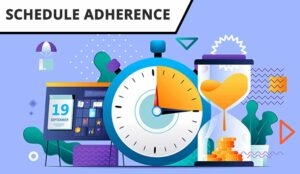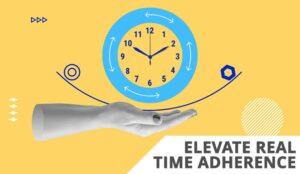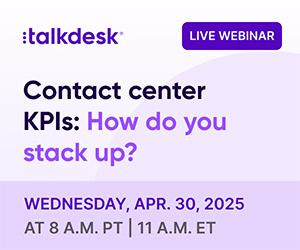For contact centre managers, knowing how precisely agents are adhering to their schedules and assigned tasks is crucial – as falling behind with either can negatively impact productivity and customer service levels. But it can be tricky to encourage your frontline to buy in to the importance.
So how do you change this for the better? To find out, we asked our panel of experts for their top tips and techniques for turning your adherence strategy around.
Here’s what they said…
1. Stop Being Too Lenient and Overlooking Repeated Issues
Set the right tone for real-time adherence (RTA) oversight by balancing support and performance. For example, making time for one-to-one conversations that foster both.
Also, establish clear consequences (as without them, RTA targets lose their meaning) and avoid micromanagement. Instead prevent intervention fatigue by focusing on significant breaches.
And finally, consistently enforce the rules! Avoid being too lenient or overlooking repeated issues.
Contributed by: Grace Dawson, Junior Sales Executive, Odigo
2. Monitor for High Stress Levels So Supervisors Know When to Step in With Additional Support

Piazza
Ensuring that agents are provided with a healthy work environment and monitoring their wellbeing is an impactful way to improve adherence.
For example, your conversation intelligence solution might use the context of the conversation (particularly the agent’s reactions) and the tonality of an agent’s voice to monitor their sentiment and stress levels during customer interactions.
If the system detects signs of negative sentiment, it can trigger interventions such as suggesting a break, providing stress-relief tips, or alerting supervisors to provide additional support.
Contributed by: Victoria Piazza, Marketing Manager, MiaRec
For the common sources of contact centre stress and how to address them in order to better support advisors, read our article: Employee Wellbeing: How to Reduce Contact Centre Stress
3. Don’t Let Unexpected Tasks Affect Your Agents’ Adherence Scores

Budding
Some workforce management (WFM) solutions with real-time adherence functionality include alarms with configurable thresholds, which can be set to flag up when schedules are being breached so managers can quickly act when necessary.
It is important that agents are made aware that increased visibility is to enable better support, which is especially important for those hybrid/remote workers.
In situations where agents are off schedule for circumstances outside their control – for example, getting called away to do an unexpected task – this could be “approved”, so their adherence score isn’t affected.
Contributed by: Scott Budding, Sales Engineering Manager, UK & EMEA, Calabrio
4. Avoid Overly Ambitious Targets – As These Just Demotivate Agents
Set challenging, yet attainable targets, as this helps prevent complacency and encourages continuous improvement.
Avoid overly ambitious targets, as these can lead to demotivation, frequent breaches, and insincere conversations.
Set challenging, yet attainable targets, as this helps prevent complacency and encourages continuous improvement.
Account for varied agent capabilities too! Low performers or new starters often struggle with schedule adherence due to longer Average Handling Time (AHT), extended wrap-up times, and the need for additional support.
Whilst complex interactions can overrun, targets for specialist and more experienced teams should reflect these challenges.
Contributed by: Grace Dawson, Junior Sales Executive, Odigo
If you are looking for other ways contact centre leaders are unintentionally demotivating their frontline staff and what to do about it, read our article: 35 Surefire Ways to Demotivate Your Best Agents
5. Give Positive Reinforcement (and Bonuses) for Good Adherence
Encourage a high level of schedule commitment by giving positive reinforcement such as team recognition or bonuses for good adherence.
When challenges with adherence arise, discuss their impacts openly and work together on realistic improvement plans during appraisals. Such awareness of their adherence being monitored can already positively influence the agents’ schedule management.
Contributed by: Simon Waldron, Customer Success Manager, injixo
6. Set Up Alerts So Supervisors Know When Tasks Are Taking Longer Than Normal

Forino
AI is transforming how organizations can monitor and improve adherence. No longer do supervisors have to manually track employees’ performance by subjectively pulling certain interactions.
Now they have a complete, holistic view of how and what an employee is doing at any time across 100% of interactions.
AI can also provide alerts to supervisors to let them know when employees are taking longer than normal on tasks or if they are not following their schedule so supervisors can step in and get things back on track.
Contributed by: Catherine Forino, Senior Product Marketing Manager, NICE
7. Clearly Communicate What ‘Good Adherence’ Looks Like

Holmes
What ‘good adherence’ looks like needs to be clearly communicated and understood across your contact centre – and not used as a ‘big stick’ to beat agents with.
For example, an agent could be on a complex call and due to go on a break, but they want to resolve a query or issue for the customer, regardless of how long it takes.
Setting a realistic adherence target should take care of instances like this and make the agent’s next steps clear.
Adherence should not just be measured using technology either! It should be managed by team leaders and managers through good communication and coaching to ensure fairness and consistency, which makes it much more accepted as part of the company culture, rather than just another metric.
Contributed by: Anne Holmes, Account Director, SVL Business Solutions
For advice on improving how you communicate, read our article: How to Master the 7 Cs of Effective Communication
8. Sync Agents’ Shift Schedules With Their Smartphone Calendars

Lim
In today’s modern workplace and digital age, leverage the widespread availability of smartphones by enabling agents to subscribe and sync their shift schedules with their mobile devices.
By integrating work schedules with personal digital calendars, agents can receive automatic reminders and notifications just as they do for personal events.
This accessibility makes it easier for agents to keep track of their schedules and adhere to their assigned shifts.
By providing tools that integrate smoothly into the agents’ daily tech use, you can significantly improve adherence rates and streamline schedule management, making it more intuitive and less disruptive to their daily routine, thereby improving contact centre adherence and overall operational efficiency.
Contributed by: Isabel Lim, Product Marketing Manager, injixo
9. Give Agents Real-Time Support to Help Them Do Their Best Work in a Timely Manner
Effective coaching is one of the most useful ways to help your agents do their best work in a timely manner.
However, supervisors cannot give feedback after every call and are often too busy to design individualized coaching plans.
Generative AI can offer tips after particular calls by providing feedback and suggesting next steps, and by offering real-time assistance to agents during calls by suggesting responses or providing additional information by scouring internal knowledge bases and help articles.
Combining human coaching and the power of AI will ensure that your agents always have the support they need to proceed with their tasks.
Contributed by: Victoria Piazza, Marketing Manager, MiaRec
If you are looking for the best top tips, tools, and techniques for improving real-time adherence, read our article: 10 Tips to Elevate Real-Time Adherence
10. Differentiate Between Operational Issues, Hot Spots and Personnel Troubles

Dawson
As adherence challenges stem from various factors, a nuanced approach is often called for.
While persistent issues may be triggered by familiar problems like tech or training, others require some detective work.
Recognizing a correlation between peak contact times or cyclical events like monthly billing enables proactive solutions which get to the root of the problem, such as enhancing self-service touchpoints and supporting agent efficiency during peak call volumes with AI next-step suggestions.
Alternatively, accounting for more subtle triggers such as meetings, school holidays, the school run or even the time of day/year may require opening the floor to innovative ways of tackling these problems.
Or perhaps identification simply means knowing when to take a step back, if temporary triggers outside a contact centre’s control are at work.
Contributed by: Grace Dawson, Junior Sales Executive, Odigo
For more great insights and advice from our panel of experts, read these articles next:
- Move Over Omnichannel… Intelligent Omnichannel Is Here!
- Seeing Double? 10 Ways to Drive Down Repeat Contacts
- Top 10 Signs of Broken Processes (and How to Fix Them)
Author: Robyn Coppell
Reviewed by: Xander Freeman
Published On: 24th Jun 2024 - Last modified: 1st Jul 2024
Read more about - Workforce Planning, Adherence, Calabrio, Catherine Forino, Editor's Picks, Grace Dawson, Isabel Lim, MiaRec, NICE, Odigo, Peopleware, Real-Time Management, Scheduling, Scott Budding, Simon Waldron, Top Story, Victoria Piazza, Workforce Management (WFM)






































